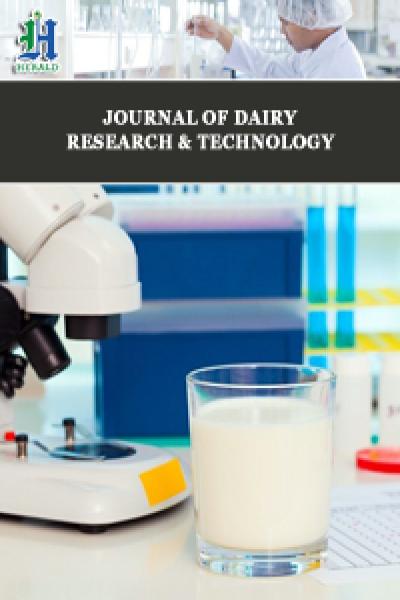
A Review on the Role of Energy Balance on Reproduction of Dairy Cow
*Corresponding Author(s):
Tesfaye NigussieCollege Of Veterinary Medicine, Mekelle University, Tigray, Ethiopia
Email:niguseyel73@gmail.com
Abstract
Energy is the major nutrient required in the feeding of dairy cattle and inadequate energy intake has a detrimental impact on their reproductive activity. When dry matter intake does not meet increased energy requirements, a status of negative energy balance develops. Negative energy balance may begin pre-partum in association with declining feed intake. During the first three weeks of lactation, negative energy balance delays early ovulation and recovery of postpartum reproductive function and provides the major nutritional link to low fertility in lactating dairy cows. Negative energy balance may detrimentally impact the oocyte that is released after ovulation and reduce the conception rate to insemination. Cows under negative energy balance have extended periods of an ovulation. Postpartum anestrus, as well as infertility is magnified by losses of body condition during the early postpartum period associated with negative energy balance. Evaluation of body condition score is an effective way to assess the amount of metabolic energy stored as subcutaneous fat and muscle on the dairy cow. Maximizing dry matter intake during the transition period, minimizing the incidence of peri-parturient problems, reducing dry period, adding supplemental fat to diets and manipulating the fatty acid content of fat sources are expected to benefit reproduction in dairy cattle.
Keywords
Dairy cattle; Dry matter intake; Negative energy balance; Reproduction
LIST OF ABBREVIATIONS
AI: Artificial Insemination
BCS: Body Condition Scoring
BHBA: Beta Hydroxyl Butyric Acid
CI: Calving Interval
CNS: Central Nervous System
COD: Cystic Ovarian Disease
DMI: Dry Matter Intake
FA: Fatty Acid
FSH: Follicle Stimulating Hormone
GH: Growth Hormone
GHR-1A: Hepatic Growth Hormone Receptor
GnRH: Gonadotropin Releasing Hormone
IGF-I: Insulin-Like Growth Factor-I
LH: Luteinizing Hormone
NEB: Negative Energy Balance
NEFA: Non-Esterified Fatty Acids
TAG: Tri Acyl Glyceride
INTRODUCTION
The dairy industry depends on reproductive performance of their dairy cows in order to meet the growing demand products. According to the report of FAO, Butler, Royal et al., Moore and Thatcher [1-4], even if there has been dramatically increased milk production of dairy cows as a result of genetic selection and improved management of herds for the last decades, but their fertility or reproductive performance has decreased. The root cause of the declining performance and health of dairy is a combination of a variety of psychological and management factors that have an additive effect on reproductive efficiency. The lactation cycle is dependent on the cow’s ability to become pregnant since the hormones released during and after pregnancy are necessary for the development of the mammary gland and increase production of milk and milk products [5].
The genetic progress or selection for high milk production in dairy cattle has changed endocrine profiles of cows so that blood concentrations of bovine somatotropin and prolactin have increased; whereas insulin has decreased [6]. These hormonal changes and the increased nutrient demands for milk production has negative impact on reproduction of dairy cows [7].
Regular breeding depends on the normal function of reproductive system and in order to breed regularly, the cow needs to have functional ovaries, display oestrous behaivour, mate, conceive, sustain embryo through gestation, calve and resume ovarian cyclicity and restore uterine function after calving [8]. Among the major reproductive problems, direct impact on reproductive performance of dairy cows are abortion, dystocia, Retained Fetal Membrane (RFM), pyometra, metritis, prolapse (uterine and vaginal), anoestrus and repeat breeding. They are classified as before gestation (anoestrous and repeat breeding), during gestation (abortion, vagina prolapse and dystocia) and after gestation (retained fetal membrane and uterine prolapse [9]. In dairy cattle reproductive processes, the post-partum period is the most varied and vulnerable to problems and that incidentally coincides with the peak of milk production, uterine involution, and resumption of ovarian activity, conception and greater risk to infection [10].
According to Santos [11], selection of dairy cattle for milk yield has linked the endocrine and metabolic controls of nutrient balance and reproductive events so that reproduction in dairy cattle is compromised during periods of nutrient shortage such as that occurring during the early lactation period.
In particular, energy is the major nutrient required by adult cattle and imbalance energy intake has a detrimental impact on reproductive activity of dairy cows. Energy shortage during the growth period and in the pre- and postpartum period inhibits onset of estrus (increases percentage of anestrous cows) and reduces fertility in females, because during a Negative Energy Balance (NEB), growth and follicular maturation are inadequate, resulting in poor estrus manifestation and reduces the possibility for having a high percentage of cows that have initiated estrous cycles for further breeding [12,13].
The energy costs to synthesize and secrete hormones, to ovulate a follicle and sustain an early developing embryo are probably minimal compared to the energy required for maintenance and lactation. However, the metabolic and endocrine cues associated with NEB impair resumption of ovulatory cycles, oocyte and embryo quality and establishment and maintenance of pregnancy in dairy cattle [11]. These results, in considerable economic loss to the dairy industry due to slower uterine involution, reduced reproductive rate, prolonged inter-conception and calving interval, negative effect on fertility, increased cost of medication, drop in milk production, reduced calf crop and early depreciation of potentially useful cows [14]. Therefore with such background information, the objective of this seminar paper aimed to:-
? Reviewing the role of energy balance on the reproductive performance of dairy cows while forwarding some nutritional management strategies which help to minimize NEB and the associated losses in reproductive performance of dairy cattle.
THE ROLE OF ENERGY BALANCE ON REPRODUCTION OF DAIRY COWS
Role of energy balance on reproduction and production
Feeding management should be aimed at minimizing loss of body condition during the early postpartum period and incidence of metabolic disorders during early lactation which will increase the number of cows experiencing a first ovulation during the first 4 to 6 weeks postpartum [18,19]. In high genetic merit cows, feed intake and energy balance begin decreasing pre-partum that results in mobilization of body fat as Non Esterified Fatty Acids (NEFA) into the blood [20].
Success in dairying includes managing all phases of production cycle. A cow’s nutrient requirements in early gestation are not much different from her maintenance requirements, but her needs increase as the fetus inside her grows and if a cow is lactating, she needs a much higher level of protein and energy than during pregnancy. There are main stages in the lactation cycle of the dairy cow: Early lactation (14-100 days); mid lactation (100 to 200 days) and late lactation (200-305 days). Based on this five distinct feeding phases can be defined to attain optimum production, reproduction and health of dairy cows [21].
Early lactation: Early lactation comprising of the period 0 to 70 days post calving and it is time in which peak milk production occurs; feed intake is lagging and cows are usually losing weight (milk yield increases more rapidly than dry matter intake (peak production). The demand for energy is therefore higher than the amount of energy consumed. Thus, the cow mobilizes body reserves and losses weight (negative energy balance). The genetic potential is usually expressed during this period and the cow will be under pressure to produce a large amount of milk. However, the cow at this stage has a limited capacity to ingest the required amount of feed. Thus, it is normal for the cow to mobilize body fat during early lactation. The ability of the dairy cow to mobilize body fats contributed to its genetic potential (i.e., cows with higher genetic potential will mobilize body fats for a longer period of time than cows with a lower genetic potential). During this period, the cow could lose as much as 0.7 kg/day. According to Zurek, et al., [22] at least 80% of dairy cows experience NEB during early lactation and its magnitude and duration depend more on feed intake than milk yield [21].
Mid-and late lactation: This period falls within the period 140 to 305 days post calving and it is accompanied by a decline in milk production [21].
Mid-lactation period is the period from day 100 to day 200 after calving. By beginning of this phase, cows will have achieved peak production (8-10 weeks after calving). Peak dry matter intake has also occurred with no more weight losses (Figure 1). Cows should reach maximum dry matter intake no later than 10 weeks after calving. At this point, cows should be eating at least 4% of their body weight. The cow should be fed a ration that will maintain peak production as long as possible. For every 2 kg of expected milk production, large-breed cows should eat at least one kg of dry matter. The main target during this period is to maintain peak milk productions as long as possible. For each extra kg of milk at peak production, the average cow will produce 200-225 kg more milk for the entire lactation. Thus, the key strategy during mid lactation is to maximize dry matter intake. During this period, the cow should be fed high quality forage (minimum 40 to 45% of the ration dry matter) and the level of effective fiber should be maintained at a level similar to that of early lactation. Concentrates should not exceed 2.3% of body weight and sources of non-forage fibers such as beet pulp, distiller’s grains and cereal bran can replace part of the starch in the ration to maintain a healthy rumen environment. Protein requirements during mid lactation are lower than in early lactation. Therefore, rations for dairy cows in mid-lactation should contain 15-17% crude protein. During this period, the cow should be bred to initiate a new pregnancy (60-70 days after calving [21].
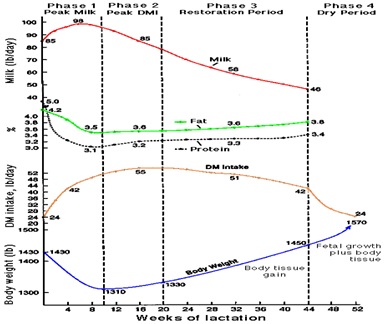 Figure 1: Association between lactation and energy demands in post partum dairy cow.
Figure 1: Association between lactation and energy demands in post partum dairy cow.Source: James GL, et al. [23].
Late lactation: This phase may begin 200 days after calving and end when the cow dries off. During this period, milk yield continues to decline and so does feed intake. However, the intake easily matches milk yield. The cow also gains weight during this period to replenish the adipose tissue lost during early lactation (Figure 1). However, as lactation approaches an end, more of the increase in body weight is due to the increased size of the growing fetus [21].
Transition or close-up period: During the lactation cycle there is essentially one opportunity to establish the lactation and ensure good health and reproduction.
The transition period: The transition period refers to the time between 60 days prior to and 60 days after calving; the most critical time within this period is the 21 days before and after calving. Correct feeding and management during the transition period has a profound effect on Dry Matter Intake (DMI). DMI is a major factor influencing both milk yield and body weight change in early lactation. Higher DMI earlier in lactation reduces the time that cows are in negative energy balance. Minimizing the duration and extent of a negative energy balance also has a positive impact on reproduction [23].
Figure 1 illustrates the shape and relationship of curves for phases of the lactation cycle with the corresponding changes in milk production, milk fat percentage, milk protein percentage, DMI and body weight.
When feed intake does not meet the increased dietary needs of milk production NEB occurs and most dairy cows are not able to meet the energy requirements for maintenance and milk production [24]. As a result of the imbalance between milk production curves and feed consumption, the cow should mobilize its body reserve in order to satisfy the energy requirements for high milk production. This determines the occurrence of NEB, i.e., the difference between the energy consumed in the feed and energy used for maintenance and production of milk is negative. It is evident that this situation is visualized by a loss of body weight (Figure 1). In relation to this the possibility to reach peak milk production with in short period after calving will depend to a great extent on the body reserve of the cow at the time of calving which in turn depends on the feeding of the cow during the dry period. Available on
http://www.extension.umn.edu/distribution/livestocksystems/DI0469.html#tc [22].
Energy balance-related factors affecting the resumption of ovarian activity in transition cows
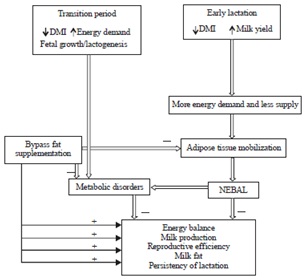 Figure 2: Short summary of energy balance of dairy cows during transition and early lactation.
Figure 2: Short summary of energy balance of dairy cows during transition and early lactation.In the female a complex hormonal interaction exists which is responsible for the maintenance of the normal ovarian cycle, adaptation of the reproductive structures to maintain and hold the embryo and fetus during the gestation period and the development and functioning of the mammary glands [8]. As its complexity, sometimes the occurrence of anomalies (abnormalities) related with reproduction starting from the time of fertilization to parturition and possibly following that should not be earth-shaking news. This may occur in the absence of any readily apparent change in management [27]. The period comprising the last 3 weeks of gestation and first 3 weeks of lactation is often referred to as the transition period, because the cow ‘transits’ from the dry period to lactation. During the transition period the final growth of the fetus and calving occur and milk production starts. In addition to increased demand to energy, nutrients and minerals the cow is also challenged by other stressors such as separation from her calf, immune challenges when the uterus is cleared [28,29], and most often also exposure to a new feeding regime and regrouping [30]. Thus, it is not surprising that there is an over-all increased risk of health disturbances during the transition period [31].
During late pregnancy elevated plasma levels of steroid hormones (estradiol and progesterone) suppress the release of pituitary gonadotropins (Luteinizing Hormone (LH) and Follicle Stimulating Hormone (FSH)) and ovarian follicular activity. Following calving, steroids are reduced and increased secretion of FSH and LH pulses become re-established to stimulate development of large ovarian follicles and ovulatory ovarian cycles [2]. During the first three weeks of lactation, NEB delays early ovulation and recovery of postpartum reproductive function and provides the major nutritional link to low fertility in lactating dairy cows. When cows experience a period of NEB, greater concentrations of Growth Hormone (GH) and the blood concentrations of NEFA increase, at the same time that Insulin-Like Growth Factor-I (IGF-I), glucose and insulin are low [32]. These shifts in blood metabolites and hormones might compromise ovarian function and fertility. With the onset of lactation, the liver must support a heavy and rapidly increasing metabolic load for glucose production and fatty acid oxidation. Excessive mobilization of body reserves has been associated with postpartum fat infiltration of the liver and reduced reproductive performance in high yielding dairy cows [33]. The liver plays an important role as a site of NEFA metabolism and as the primary source of IGF-I that stimulates development of ovarian follicles. The functional activities of these various tissues are negatively influenced by NEB [2].
Metabolic hormones and re-initiation of post partum ovarian activity: Regulation of cyclical activity is mainly under the control of the hypothalamic-pituitary-ovarian axis. At one end of this axis there is the influence of the extra hypothalamic areas-the cerebral cortex, thalamus and mid-brain and the role played by stimuli such as light, olfaction and touch whilst at the other end is the influence of the uterus upon the ovary [8].
As described by Butler, et al., [26] by way of various metabolic factors, interactions and responses, NEB shifts the course of postpartum ovarian activity and strongly influences the resumption of ovulatory cycles as NEB acting through the combined metabolic signaling of low blood glucose and insulin concentrations along with elevated NEFA, β hydroxybutyrate (BHBA) and liver accumulation of triglycerides delays the increases in LH and FSH necessary for stimulation of ovarian follicles, estradiol production, and ovulation (Figure 3)[6].
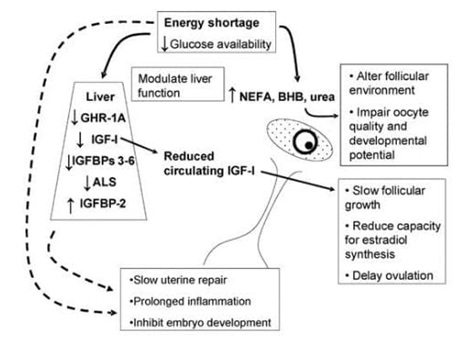 Figure 3:Summary diagram showing how negative energy balance may influence fertility through effects on the liver, ovary and uterus.
Figure 3:Summary diagram showing how negative energy balance may influence fertility through effects on the liver, ovary and uterus.Dairy cows with reduced concentrations of glucose in blood have reduced progesterone in plasma [34]. Low blood insulin concentrations are responsible for low IGF-I production from the liver [2,35] which together reduce responsiveness of ovarian follicles to gonadotropins. Physiologically the metabolic and gonadotropin signals controlling early follicle development are interrelated: FSH stimulates granulosa cells in follicles to develop receptors for insulin, growth hormone and IGF-I; insulin and IGF-I then provide the hormonal stimulus for full development of preovulatory ovarian follicles [36].
The degree of NEB alters whether LH pulse frequency during the first follicular wave is sufficient to stimulate high estradiol production for ovulation [37]. LH is a critical hormone which is required for re-establishment of ovarian activity, final growth and maturation of the ovulatory follicle, ovulation, and ovarian secretion of progesterone [25].
Body Condition Score (BCS) is one major cow factor related to a decrease in DMI during the close-up dry period. Over-conditioning (BCS > 4) reduces DMI [38] and increases the risk of metabolic disorders. It is well established that DMI on day 21 of lactation is directly related to DMI on the day before calving [39].
Energy intake appears to have the greatest impact on energy status of lactating dairy cows. Villa-Godoy, et al., [40] reported that variation in energy balance in postpartum Holstein cows was influenced most strongly by DMI and less by milk yield. Therefore, differences among cows in the severity of NEB are more related with how much energy they consume than with how much milk they produce. Moreover, Bell [18] also reported the severity of the NEB is more pronounced in primiparous cows, as they have energy requirements for their own growth in addition to the energy demands for foetal growth, mammary development and their first lactation. As reported by Nebel and McGilliard [7], NEB was more severe for non-ovulatory cows. Severe NEB prevents a more effective immune response to microbial challenge after calving, prolonging the time required for uterine recovery and compromising subsequent fertility (Figure 4)[41,42].
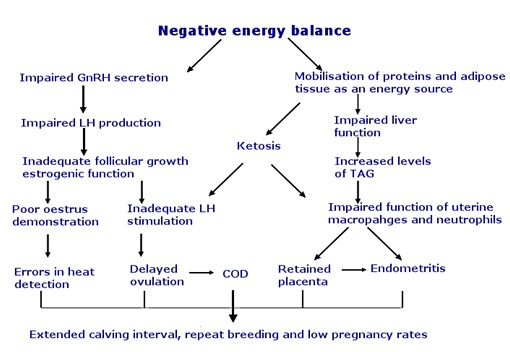 Figure 4: Associations between NEB and some endocrine and immune functions in dairy cows.
Figure 4: Associations between NEB and some endocrine and immune functions in dairy cows.Source: MSD Animal Health [43].
Evaluation of body condition score as indicator of reproductive performances
|
Status |
Optimum |
Acceptable Range |
|
Calving |
3.5 |
3.0 - 4.0/3-3.5 |
|
Peak lactation |
2.5 |
2.0 - 2.5 |
|
Mid lactation/late lactation |
3.0 |
3.0 - 3.5 |
|
Dry period |
3.5 |
3.0 - 3.5 |
As explained by Nebel and McGilliard in 1993 [7], during early lactation, reproductive performance of dairy cows, particularly conception rate are negatively associated with the magnitude of the NEB delayed ovulation and insemination provides some explanation for the observed low pregnancy rate; however, as loss of BCS becomes more extensive, the reduction in conception rate to AI becomes greater. Cows losing one unit or more BCS (5 point scale) during early lactation are at greatest risk for low fertility. As a guideline, conception rate decreases about 10% per 0.5 unit BCS loss [48,19]. Extended calving to conception intervals were associated with low BCS by week +7 and greater peak milk yield [49]. Otto, et al., [50] reported that one BCS change in dairy cattle equals 25-60 kg change in live weight. Cows with more severe NEB lose more BCS during the first 30 days of lactation and experience longer intervals to first ovulation [51] which might negatively influence milk yield, whereas low producing dairy cows lose less BCS than high producing dairy cows [52]. Generally, the first postpartum ovulation in dairy cattle occurs 10 to 14 day after the nadir of NEB [2]. Severe weight and BCS losses caused by inadequate feeding or illnesses are associated with an ovulation and an estrus in dairy cattle. In fact, cows with low BCS at 65 days postpartum are more likely to be an ovular; which compromises reproductive performance at first postpartum insemination [53]. Table 2 gives summary of the effects of BCS losses in early lactation on conception rate in dairy cattle affected by NEB.
|
Loss in BCS |
Conception Rate |
|
Less than 1 unit |
50% |
|
From 1 to 2 units |
34% |
|
More than 2 units |
21% |
Table 2: Effect of BCS losses in early lactation on conception rate.
Source: James GL, et al. [23].
Table 3 gives summary of the consequences of NEB and high metabolic rates on reproduction in dairy cattle.
|
Metabolic Profile |
Metabolic and Functional Changes |
Endocrine Changes |
Functional Changes |
|
NEB |
Impaired synthesis and secretion of GnRH and LH |
Anoestrus, |
Poor oestrus demonstration, |
|
Emergency energy production from adipose tissue and proteins |
Increased levels of triacylglycerols in circulation (impaired liver function), |
Impaired immune function of endometrium and increased susceptibility to uterine infections, |
|
|
Increased Metabolic Rates |
Increased metabolism of oestradiol and progesterone in the liver |
Decreased levels of oestradiol in circulation, |
Poor oestrus demonstration |
Table 3: The consequences of NEB and high metabolic rates on reproduction in dairy cows.
Source: MSD Animal Health [43].
MANAGEMENT STRATEGY OF NEGATIVE ENERGY BALANCE
Increased energy intake to improve energy balance ( nutritional strategy)
Insulin is important as a signal mediating the effects of acute changes in nutrient intake on reproductive parameters in dairy cattle. In early postpartum dairy cattle under NEB, reduced expression of hepatic growth hormone receptor 1A (GHR-1A) is thought to be responsible for the lower concentrations of IGF-I in plasma of cows [55]. Because IGF-I is an important hormonal signal that influences reproductive events such as stimulation of cell mitogenesis, hormonal production and embryo development, among other functions; increasing concentrations of IGF-I early postpartum are important for early resumption of cyclicity and establishment of pregnancy. Insulin mediates the expression of GHR-1A in dairy cows [2,56], which results in increased concentrations of IGF-I in plasma. Because IGF-I and insulin are important for reproduction in cattle, feeding diets that promote greater insulin concentrations should benefit fertility. Gong, et al., [57] fed to cows of low and high genetic merit isocaloric diets that differed in the ability to induce high or low insulin concentrations in plasma. The diets that induced high insulin reduced the interval to first postpartum ovulation and increased the proportion of cows ovulating in the first 50 days postpartum. Re-initiation of postpartum ovarian activity is closely related to the feeding and management during the transition period and the metabolic and physiological changes that it implies (Figure 5) [19].
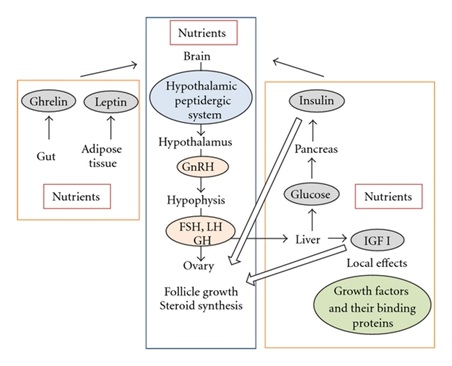 Figure 5: Schematic representation of mechanisms by which nutrition influences reproductive function.
Figure 5: Schematic representation of mechanisms by which nutrition influences reproductive function.Source: Garcia-Garcia RM [58].
Decreasing the length of the dry period
CONCLUSION AND RECOMMENDATIONS
Inadequate intake of energy and inadequate body reserves during early lactation are the major factors affecting reproductive performance of dairy cows. Metabolic changes in peri-parturient cows associated with onset of NEB appear most responsible for the coordinated detrimental effects on metabolic health and reproductive performance. NEB during early lactation is related to decreasing feed intake pre-partum and provides the major nutritional link to low fertility in lactating dairy cows. NEB delays early ovulation and recovery of postpartum reproductive function and exerts carryover effects that reduce fertility during the breeding period.
Based on the above conclusion, the following recommendations are forwarded:
- Perform good management practices, as management of DMI, nutrition and metabolic health of lactating cows for improved reproductive performance begins in the transition period and continues through early lactation
- Avoiding any stress and balancing the feed intake
- Awareness creation and educating farmers about feeding during the pre and post- partum period, method of increasing palatability of available feed
- Farmers need to practice BCS for evaluating the nutritional management of the dairy cows as over-conditioning (BCS > 4) reduces DMI and increases the risk of metabolic disorders. Maintaining moderate BCS (~3) until calving is currently recommended
REFERENCES
- Food and Agriculture Organization (2005) The State of Food and Agriculture. Production year book, Food and Agriculture Organization of the United Nations, Rome, Italy. Pg No: 233.
- Butler WR (2003) Energy balance relationships with follicular development, ovulation and fertility in postpartum dairy cows. Livest Prod Sci 83: 211-218.
- Royal MD, Darwash AO, Flint APE, Webb R, Woolliams JA, et al. (2000) Declining fertility in dairy cattle: Changes in traditional and endocrine parameters of fertility. Animal Science 70: 487-501.
- Moore K, Thatcher WW (2006) Major advances associated with reproduction in dairy cattle. Journal of Dairy Science 89: 1254-1266.
- Badinga L, Collier RJ, Wilcox CJ, Thatcher WW (1985) Interrelationships of milk yield, body weight, and reproductive performance. J Dairy Sci 68: 1828-1830.
- Bonczeck RR, Young CW, Wheaton JE, Miller KP (1988) Responses of somatotropin, insulin, prolactin, and thyroxine to selection for milk yield in Holsteins. J Dairy Sci 71: 2470-2479.
- Nebel RL, McGilliard ML (1993) Interactions of high milk yield and reproductive performance in dairy cows. J Dairy Sci 76: 3257-3268.
- Noakes DE, Parkinson TJ, England GW, Arthur GH (2001) Veterinary reproduction and obstetrics, (8th edn), Elsevier, Amsterdam, The Netherlands.
- Lobago F, Bekana M, Gustafsson H, Kindahl H (2006) Reproductive performances of dairy cows in smallholder production system in Selalle, Central Ethiopia. Trop Anim Health Prod 38: 333-342.
- Robert SJ (1971) Veterinary obstetrics and genital diseases (Theriogenology) (5th edn), Edwards Bros, Michigan, USA.
- Santos JEP (2008) Nutrition and reproduction in dairy cattle. Tri-State Dairy Nutrition Conference, Columbus, USA.
- Hileman SM, Lubbers LS, Jansen HT, Lehman MN (1999) Changes in hypothalamic estrogen receptor-containing cell numbers in response to feed restriction in the female lamb. Neuroendocrinology 69: 430-437.
- Kumar N (2005) Reproduction in rural bovine, Indian veterinary res. inst Pg No: 42-58.
- Erb HW, Martin SW (1980) Interrelationships between production and reproductive diseases in holstein cows. Data. J Dairy Sci 63: 1911-1917.
- Jolly PD, McDougall S, Fitzpatrick LA, Macmillan KL, Entwistle KW (1995) Physiological effects of undernutrition on postpartum anoestrus in cows. J Reprod Fert 49: 477-492.
- Mulligan FG, Grady LO, Gath VP, Rice DA, Doherty ML (2006) Nutrition and fertility in dairy cow. Irish Veterinary Journal 60: 567-569.
- Laflamme LF, Connor ML (1992) Effect of postpartum nutrition and cow body condition at parturition on subsequent performance of beef cattle. Canadian Journal of Animal Science 72: 843-851.
- Bell AW (1995) Regulation of organic nutrient metabolism during transition from late pregnancy to early lactation. J Anim Sci 73: 2804-2819.
- Santos JE, Rutigliano HM, Sá Filho MF (2009) Risk factors for resumption of postpartum estrous cycles and embryonic survival in lactating dairy cows. Anim Reprod Sci 110: 207-221.
- Butler ST, Pelton SH, Butler WR (2006) Energy balance, metabolic status, and the first postpartum ovarian follicle wave in cows administered propylene glycol. J Dairy Sci 89: 2938-2951.
- http://smallfarms.oregonstate.edu/sites/default/files/feeding_milking_cow.pdf
- Zurek E, Foxcroft GR, Kennelly JJ (1995) Metabolic status and interval to first ovulation in postpartum dairy cows. J Dairy Sci 78: 1909-1920.
- James GL, Michael FH, Randy S, Donald E, Howard OW, et al. (2008) Feeding the dairy herd. University of Minnesota, Madison, USA.
- Waltner SS, McNamara JP, Hillers JK (1993) Relationships of body condition score to production variables in high producing Holstein dairy cattle. J Dairy Sci 76: 3410-3419.
- Butler ST, Pelton SH, Knight PG, Butler WR (2008) Follicle-stimulating hormone isoforms and plasma concentrations of estradiol and inhibin A in dairy cows with ovulatory and non-ovulatory follicles during the first postpartum follicle wave. Domest Anim Endocrinol 35: 112-119.
- Galvão KN, Frajblat M, Butler WR, Brittin SB, Guard CL, et al. (2010) Effect of early postpartum ovulation on fertility in dairy cows. Reprod Domest Anim 45: 207-211.
- Hafez ESE, Hafez B (2013) Reproduction in farm animals (7thedn). Wi¬ley-blackwell, New Jersey, USA.
- Salasel B, Mokhtari A, Taktaz T (2010) Prevalence, risk factors for and impact of subclinical endometritis in repeat breeder dairy cows. Theriogenology 74: 1271-1278.
- LeBlanc S (2010) Monitoring metabolic health of dairy cattle in the transition period. J Reprod Dev 56: 29-35.
- Schirmann K, Chapinal N, Weary DM, Heuwieser W, von Keyserlingk MA (2011) Short-term effects of regrouping on behavior of prepartum dairy cows. J Dairy Sci 94: 2312-2319.
- Ingvartsen KL (2006) Feeding-and management-related diseases in the transition cow: Physiological adaptations around calving and strategies to reduce feeding-related diseases. Animal Feed Science and Technology 126: 175-213.
- Canfield RW, Butler WR (1991) Energy balance, first ovulation and the effects of naloxone on LH secretion in early postpartum dairy cows. J Anim Sci 69: 740-746.
- Butler WR, Smith RD (1989) Interrelationships between energy balance and postpartum reproductive function in dairy cattle. J Dairy Sci 72: 767-783.
- Vasconcelos JL, Sangsritavong S, Tsai SJ, Wiltbank MC (2003) Acute reduction in serum progesterone concentrations after feed intake in dairy cows. Theriogenology 60: 795-807.
- Shimizu T, Murayama C, Sudo N, Kawashima C, Tetsuka M, et al. (2008) Involvement of insulin and Growth Hormone (GH) during follicular development in the bovine ovary. Anim Reprod Sci 106: 143-152.
- Beam SW, Butler WR (1999) Effects of energy balance on follicular development and first ovulation in postpartum dairy cows. J Reprod Fertil 54: 411-424.
- Drackley JK, Dann HM, Douglas GN, Janovick Guretzky NA, Litherland NB, et al. (2005) Physiological and pathological adaptations in dairy cows that may increase susceptibility to periparturient diseases and disorders. Ital J Anim Sci 4: 323-344.
- Trevisi E, Han XT, Piccioli-Cappelli F, Bertoni G (2002) Dry matter intake reduction before calving in dairy cows: Relationship with immune system and metabolism conditions. EAAP, Cairo, Egypt.
- Villa-Godoy A, Hughes TL, Emery RS, Chapin LT, Fogwell RL (1988) Association between energy balance and luteal function in lactating dairy cows. J Dairy Sci 71: 1063-1072.
- Huzzey JM, Veira DM, Weary DM, von Keyserlingk MA (2007) Prepartum behavior and dry matter intake identify dairy cows at risk for metritis. J Dairy Sci 90: 3220-3233.
- Wathes DC, Cheng Z, Chowdhury W, Fenwick MA, Fitzpatrick R, et al. (2009) Negative energy balance alters global gene expression and immune responses in the uterus of postpartum dairy cows. Physiol Genomics 39: 1-13.
- Partners in Reproduction (2014) Oestrus management in dairy cows. Partners in Reproduction, MSD Animal Health, USA.
- Gillund P, Reksen O, Gröhn YT, Karlberg K (2001) Body condition related to ketosis and reproductive performance in Norwegian dairy cows. J Dairy Sci 84: 1390-1396.
- Edmonson AJ, Lean IJ, Weaver LD, Farver T, Webster G (1989) A body condition scoring chart for Holstein dairy cows. J Dairy Sci 72: 68-78.
- Roche JR, Friggens NC, Kay JK, Fisher MW, Stafford KJ, et al. (2009) Invited review: Body condition score and its association with dairy cow productivity, health, and welfare. J Dairy Sci 92: 5769-5801.
- 48. Butler WR (2001) Nutritional effects on resumption of ovarian cyclicity and conception rate in postpartum dairy cows. Brit Soc Anim Sci Occasional Publication 26: 133-145.
- Patton J, Kenny DA, McNamara S, Mee JF, O'Mara FP, et al. (2007) Relationships among milk production, energy balance, plasma analytes, and reproduction in Holstein-Friesian cows. J Dairy Sci 90: 649-658.
- Otto KL, Ferguson JD, Fox DG, Sniffen CJ (1991) Relationship between body condition score and composition of ninth to eleventh rib tissue in Holstein dairy cows. Journal of Dairy Science 74: 852-859.
- 51. Butler WR (2005) Inhibition of ovulation in the postpartum cow and the lactating sow. Livest Prod Sci 98: 5-12.
- Gallo L, Carnier P, Cassandro M, Mantovani R, Bailoni L, et al. (1996) Change in body condition score of Holstein cows as affected by parity and mature equivalent milk yield. J Dairy Sci 79: 1009-1015.
- Santos JE, Bilby TR, Thatcher WW, Staples CR, Silvestre FT (2008) Long chain fatty acids of diet as factors influencing reproduction in cattle. Reprod Domest Anim 43: 23-30.
- Grant RJ, Albright JL (1995) Feeding behavior and management factors during the transition period in dairy cattle. J Anim Sci 73: 2791-2803.
- Radcliff RP, McCormack BL, Crooker BA, Lucy MC (2003) Plasma hormones and expression of growth hormone receptor and insulin-like growth factor-I mRNA in hepatic tissue of periparturient dairy cows. J Dairy Sci 86: 3920-3926.
- Rhoads RP, Kim JW, Leury BJ, Baumgard LH, Segoale N, et al. (2004) Insulin increases the abundance of the growth hormone receptor in liver and adipose tissue of periparturient dairy cows. J Nutr 134: 1020-1027.
- Gong JG, Lee WJ, Garnsworthy PC, Webb R (2002) Effect of dietary-induced increases in circulating insulin concentrations during the early postpartum period on reproductive function in dairy cows. Reproduction 123: 419-427.
- Garcia-Garcia RM (2013) Integrative control of energy balance and repro¬duction in females. ISRN Veterinary Science, International Scholarly Research Network 2012: 121389.
- Grummer RR (2007) Strategies to improve fertility of high yielding dairy farms: Management of the dry period. Theriogenology 68: 281-288.
- Grummer RR, Wiltbank MC, Fricke PM, Watters RD, Silva-Del-Rio N (2010) Management of dry and transition cows to improve energy balance and reproduction. J Reprod Dev 56: 22-28.
Citation: Nigussie T (2018) A Review on the Role of Energy Balance on Reproduction of Dairy Cow. J Dairy Res Tech 1: 003.
Copyright: © 2018 Tesfaye Nigussie, et al. This is an open-access article distributed under the terms of the Creative Commons Attribution License, which permits unrestricted use, distribution, and reproduction in any medium, provided the original author and source are credited.
